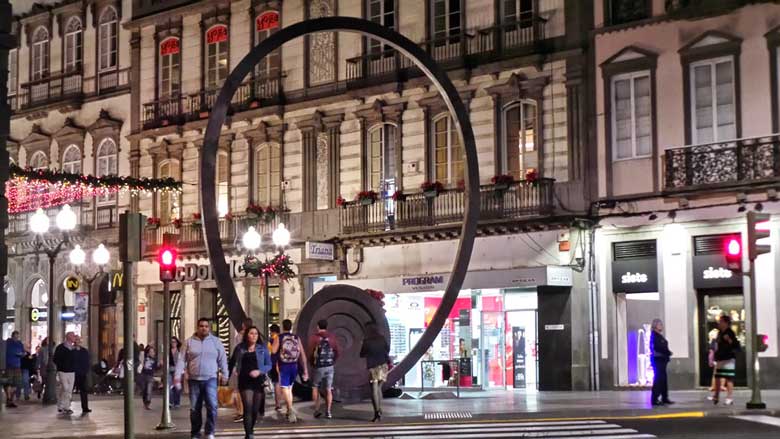 Triana
Triana
The big city of Triana takes its name from its first inhabitants from the neighborhood of the same name in Andalusia's Seville. Its main artery is the pedestrianized calle Mayor de Triana, which has long been the main shopping street. At its southern end there is the Teatro de Perez Galdos and the beautiful Plaza de San Francisco, with one of the most elegant buildings of Las Palmas - the modern Gabinete Literario z 1844 r., the seat of the first theater on the island. Currently, it is used for elegant balls and lectures, as well as temporary exhibitions, which are a good excuse, to see the sumptuous interior. There is also the Hotel Madrid on the square, where General Franco spent the last night before his coup d'état (reportedly left the hotel, without paying the bill).
Walking through the calle de Triana, worth a visit to the Casa Museo Perez Galdos in the side street of the house, in which to 19. One of the most important Spanish writers, Benito Perez Gałdos, lived in the year of his life. In a beautifully restored house, the study of the native of 1843 r. writer.
At the northern end of calle Mayor de Triana is the charming square Parque de San Telmo, with palm trees, a modest chapel of San Telmo and a nice modernist gazebo.
Tourist bus
Because Las Palmas de Gran Canaria is quite a large city, and the walk from La Vequety to Canteras Beach does not pass through attractive neighborhoods, it is worth using a special two-story vehicle. The red bus departs from the stop at Parque Catalina (codz. 9.30-18.00; co 30 min) and runs from the north to the south of the city, stopping at the most important attractions. It is worth buying a 24-hour ticket, which allows you to board the bus multiple times.
City Jardm
The garden city is the most peaceful neighborhood of Las Palmas, established at the beginning of the 20th century. by the British city elite. The elegant villas and mansions are surrounded by colorful gardens. Parque Doramas is located in the center of the district. Green alleys, water cascades and endemic species of Canarian plants create an oasis of peace in the center of a big city. Pueblo Canario is located in the park, designed by the symbolist painter Nestor Martin Fernandez de la Torre, a bit idealized typical island village, with a small cake, church, handicraft shops and a playground for children. Every Sunday approx. 11.30 performances by folklore groups take place here.
Saint Catherine
Santa Catalina is a modern neighborhood between Puerto de la Luz and the eastern stretch of Canteras Beach. Its focal point is Parque Santa Catalina – a square planted with palm trees and flower beds, where numerous cafes and restaurants are concentrated. The Museo Elder de la Ciencia y la Tecnologia operates at the square (Museum of Science and Technology). You can find out from interactive exhibitions, how the internet works, how electricity is generated and turn into an airport air traffic control tower employee for a few minutes.
Centeras Beach
Only a few blocks south, the city ends, giving way to a three-kilometer golden beach, which is considered to be one of the most beautiful city beaches in Spain. A wide strip of golden sand is washed by crystal clear water, which thanks to lying approx.
100 meters from the shore of the natural reef of La Barra de Las Canteras is extremely peaceful. The promenade that runs along the beach is filled with hotels and pleasant gardens (terraces) restaurants and cafes. At the western end of the beach rises the monumental Auditorio Alfredo Kraus, shaped like a ship going out to sea. Important cultural events take place in the auditorium designed by the Catalan Oscar Tusquets, including film festival. An alley of stars was marked out in front of the audience, where famous actors beat their hands.
port of light
Northeast of Canteras Beach lies one of the largest European harbors – port of light. You can also see Castillo de la Luz in the area, Gran Canaria's oldest defensive fortress surrounded by a rose garden. Built in the 16th century. For centuries, the castle resisted attacks by pirates and privateers. From the small hills of the volcanic-sandy headland of La Isleta there is a beautiful panorama of Las Palmas and the northern part of the island.
Okolice Las Palmas
9 km southwest of Las Palmas is the beautiful Jardin Botanico Canario Viera y Clavijo. On over 27 ha many endemic canary plants grow, including powerful cacti, draceny and palm trees. Even a piece of wild laurel forest has been recreated. The garden can be reached by buses #301, 302 i 303.
4 km south of the botanical garden is the Caldera de Bandama – the largest volcano crater on the island with a diameter of a kilometer, depth 200 m and perimeter reaching to 10 km. Pico de Bandama crater rises right next to the caldera, which offers a beautiful view of the capital of Gran Canaria. The asphalt road GC-802 leads to the top.